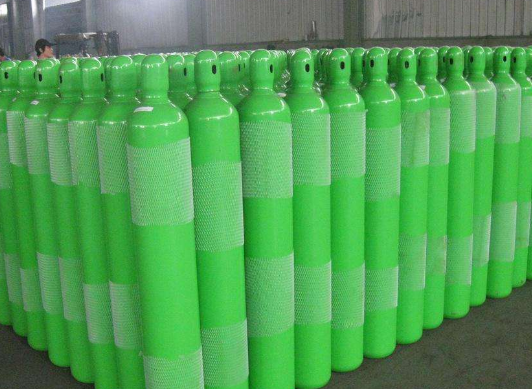
Gas cylinder types product, we offer many types of gas cylinders, by weight, 4kg, 5kg…50kg, gas carbon dioxide, natural gas, acetylene, etc., the main markets of the products are the United States, South America, Brazil, Southeast Asia, etc.
What does gas cylinder types?
Generally speaking, there are three types of cylinders: 1. High Pressure Cylinders – High Pressure Cylinders come in various sizes, as shown in Figure 1. Examples of gases supplied by high pressure cylinders include nitrogen, helium, hydrogen, oxygen and carbon dioxide.
- Liquefied gas is a kind of gas that can be changed into liquid at room temperature when it is in cylinder under pressure. They exist in cylinders in liquid-gas equilibrium or equilibrium. Common examples are anhydrous ammonia, chlorine, propane and carbon dioxide.
- Non-liquefied gases are also known as compressed gases, pressurized gases or permanent gases. These gases do not become liquids even under high pressure when compressed at room temperature. Common examples are oxygen, nitrogen, helium and argon.
- The dissolved gas is very unstable. The most common example is acetylene, which explodes even at atmospheric pressure. Acetylene cylinders are filled with inert porous fillers and saturated with acetone to prevent explosion. When acetylene is added to the cylinder, the gas dissolves in acetone to stabilize the acetylene solution.
Gas cylinder types sizes
- Cylinder Specification
- Cylinder serial number
- Date of manufacture
- Cervical Ring Recognition
- Re-testing Tags
- Barcode labels
- Inspection Marks of Cylinder Manufacturers
- Cylinder Skin Weight (Empty) Weight
Material Science
Design specifications and application standards as well as material costs determine the choice of steel for most gas cylinders that are not welded; steel is treated with corrosion protection. Some newly developed light cylinders are made of stainless steel and composite materials. Because of the very high tensile strength of carbon fibers, these containers can be very light, but more difficult to manufacture.
Cylinders reinforced or stacked with fibrous materials, such as every five years instead of 10 years, must be inspected more frequently than metal cylinders, and more thoroughly than metal cylinders.
Cylinder inspection intervals increased from 5 or 6 years to 10 years. Diving cylinders for water must be inspected more frequently. When they become less safe, some steel and aluminium alloys have stopped using.
Fiber reinforced composite cylinders were first designated for a limited life of 15, 20 or 30 years, and cylinders are now usually removed after 70 years. Over the years, there have been composite cylinders designated as non-limiting life (NLL) – as long as no damage is visible.
What is a high pressure industrial gas cylinder?
High pressure industrial cylinders are made of aluminium or steel and can safely use and transport compressed gases. Common industrial gases such as nitrogen, helium, hydrogen, oxygen and carbon dioxide are stored in these cylinder types.
High-pressure gas will cause serious health and safety hazards when it is not stored and handled correctly. Therefore, it is important to understand the health hazards of the gases you use (toxic gases, corrosive gases, asphyxiants) and the physiological and chemical hazards of the cylinders themselves.
Although many compressed gases are flammable, corrosive and self-reactive, even non-flammable and non-toxic gases can become dangerous when cylinders are loosened, heated or begin to disperse gases uncontrollably. Many workplace accidents and deaths are caused by the uncontrolled release of gases from unstable cylinders. This can turn cylinders into torpedo-like projectiles.
How many types of gas cylinders are there?
There are three main types of compressed gases stored in cylinders: liquefied gases are gases that can change into liquids at room temperature when they are in cylinders under pressure. They exist in cylinders in liquid-gas equilibrium or equilibrium.
Are empty gas cylinders dangerous?
Air may cause serious pollution and corrosion problems in cylinders. When the compressed cylinder is “empty”, it is treated as full because it contains gas.
About gas cylinder weight
The skin weight of the air bottle is about 15.3 kg. Leather weight varies from cylinder to cylinder as a result of manufacturing deviation. The exact leather weight is printed on each cylinder. This means that the total weight of a full 14.2 kg cylinder is about 29.5 kg.
What is the weight of LPG cylinder?
The weight of the empty drum (15.3 * Kg) is applied to the body of the car.
The product weight (14.2 Kg **) is added to the air cylinder weight to achieve gross weight.
Generally speaking, three of the three pillars of the leather weight are painted white, and the net weight and gross weight are painted black on their sides. The remaining residence time is annual and quarterly, in which the cylinder will be certified for further use/condemnation. Most of them weigh about 15 kilograms in leather and 14.2 kilograms in net, totaling more than 29 kilograms.
Weight of liquefied petroleum gas cylinders
The empty weight of liquefied petroleum gas cylinders is called the tare weight, which is the same as the empty weight or the unloaded weight. LPG cylinder weight is a combination of skin weight and net weight.
It is very important to know the weight of all propane tanks and empty propane tanks – Liquefied petroleum gas cylinders.
It can be said to be the best way to determine the remaining gas volume.
Full weight = empty weight + content weight.
Weight (Content) of LPG = Full Weight-Air Weight
Gas cylinder weight youtube video
You may like:
